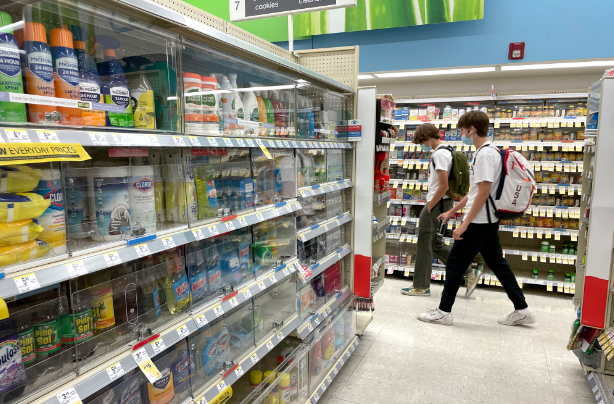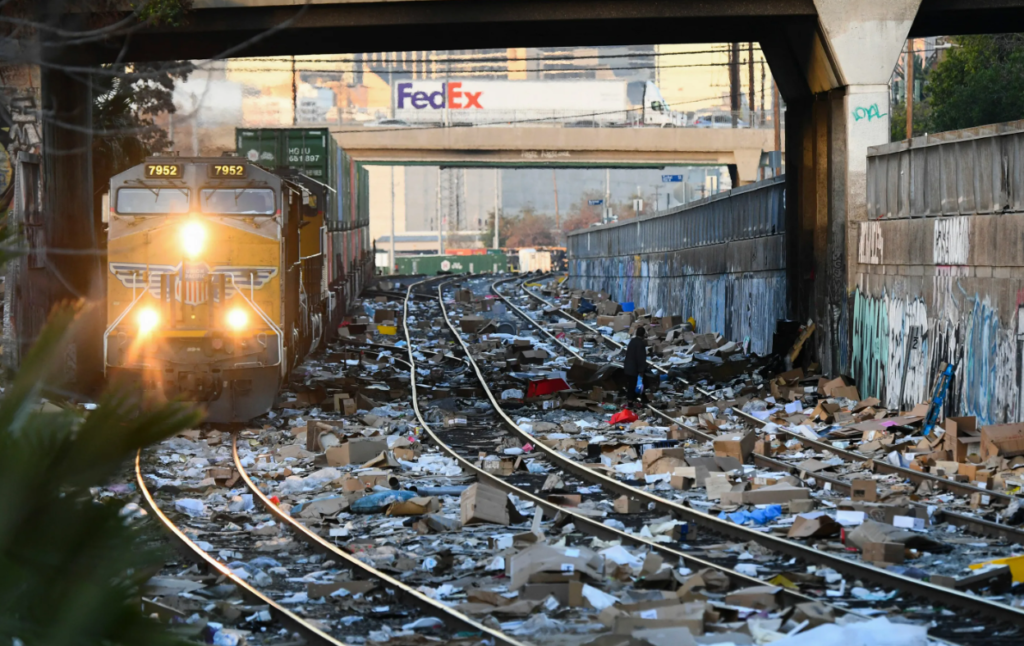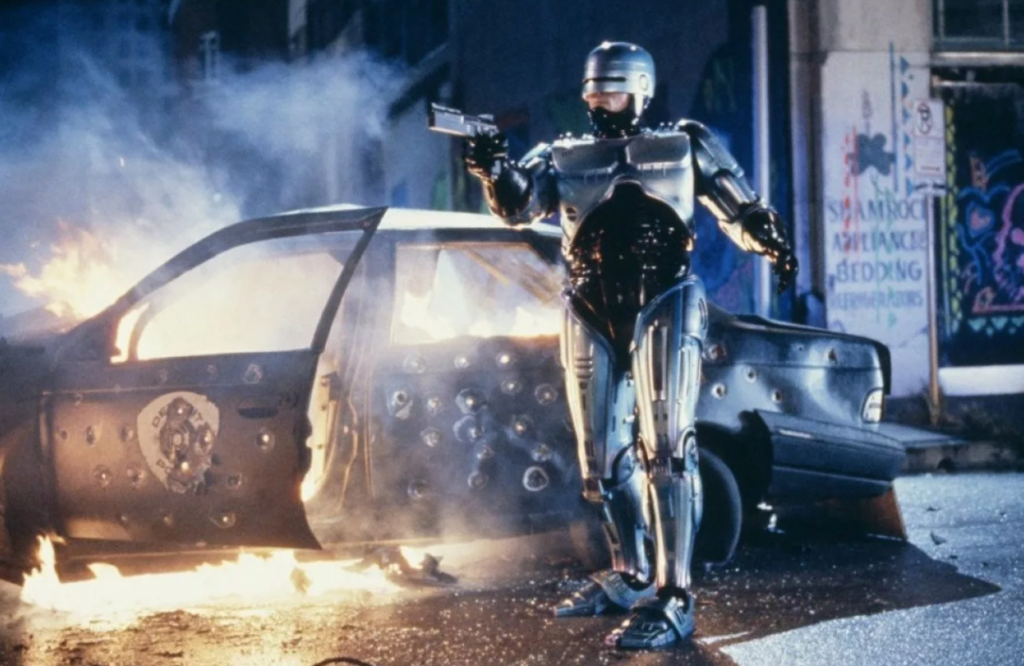In 1916, entrepreneur Clarence Saunders invented America’s first self-service grocery store, a truly revolutionary idea that swept across the country and then the world. Now, a little over a century later, the American self-service grocery store is dying, but not for a reason anyone could have predicted.
More about Clarence Saunders and his remarkable idea, from the Piggly Wiggly website:
Piggly Wiggly®, America’s first true self-service grocery store, was founded in Memphis, Tenn. in 1916 by Clarence Saunders. Back then shoppers would present their grocery orders to clerks who then gathered the goods from the store shelves. Saunders, a flamboyant and innovative man, noticed that this method resulted in wasted time and expense, so he came up with an unheard of solution that would revolutionize the entire grocery industry: he developed a way for shoppers to serve themselves.
Despite predictions that this novel idea would fail, Saunders’ first store opened September 6, 1916 at 79 Jefferson Street in Memphis. Operating under the unusual name Piggly Wiggly, it was unlike any other grocery store of that time. There were shopping baskets, open shelve and no clerks to shop for the customer—all unheard of!
Smithsonian Magazine describes the peculiar and innovative way Saunders launched his new store:
Saunders was a bit of an iconoclast. For the store’s opening ceremonies, writes Mike Freeman for the Tennessee Historical Quarterly, Saunders promised to hold a “beauty contest” that he advertised in local newspapers. “At the door Saunders shook [women’s] hands and gave to their children flowers and balloons,” Freeman writes. “Newspaper reporters posing as contest judges awarded five and ten dollar gold coins to every woman, while the supply lasted. A brass band serenaded the visitors in the lobby.”
This enthusiastic greeting was necessary because Saunders was trying something completely new. Before Piggly Wiggly, groceries were sold at stores where a clerk would assemble your order for you, weighing out dry goods from large barrels. Even chain stores used clerks.
Although the chain store model helped keep costs down, the University of Michigan Library writes, the “small army of clerks” necessary to fill orders were expensive, the university writes, and at least part of that cost was passed on to the consumer.
Saunders’s model cut costs by cutting out the clerks. Shoppers on that first day did see some employees stocking shelves, Freeman writes, “but they politely refused to select merchandise for visitors.” Just like today, a shopper picked up a basket (though Piggly Wiggly’s were made of wood, not plastic) and went through the store to purchase everything. By the end of that first year there were nine Piggly Wiggly locations around Memphis.
Over the next 100 years, American grocery stores went from this:

To this:


Even the toothpaste is locked up.
An increasing number of American stores are, effectively, no longer self-service, as most of their products have disappeared behind locked cages and cabinets. If you want to buy one of these items, you need to track down an employee to unlock it for you. Far less convenient than the first Piggly Wiggly store in 1916. And the reason, of course, is theft, across the country in almost every urban area. In an article for the Daily Mail, one Ross Dress For Less store reported being robbed up to four times a day.
Shocking videos have laid bare America’s $100 billion-per-year shoplifting crisis, with brazen thieves strolling out of stores including Home Depot and Ross Dress for Less with their arms full of stolen goods.
Surveillance footage shows a gang of crooks wearing masks wheeling shopping carts loaded with valuable products out of a Home Depot store in New York.
Another clip showed shoplifters loading up duffel bags and backpacks with perfumes and colognes from a Ross store in Colorado.
Last year, videos and photos went viral depicting railroad tracks in Los Angeles covered in the remains of destroyed packages. Gangs of bandits systematically loot every freight train that passes through, keeping high-value items they want and discarding everything else.

A Walgreens in Chicago has just been renovated with top notch security, and it looks like something out of a Judge Dredd movie:

Customers select their items on an interactive screen, and then line up at a counter for employees to handpick the items. Yes, literally the opposite of that Piggly Wiggly store 100+ years ago.
It’s quite obvious the fabric of society itself is coming apart, and would take decades or even centuries to repair if it passes a certain point of decay. It’s hard to fully understand why our oligarchs are so indifferent to this decay, or actually encouraging it. This indifference seems to be shared by a large number of everyday Americans too, which is one of the final steps of the USA’s transition from a super power to an impoverished banana republic.
Meanwhile, Biden funnels money and resources into propping up the ongoing wars on the other side of the world in Syria and Ukraine. One last great cause to be proud of before the collapse.
Judge Dredd was supposed to be a parody of dystopian fiction, but it might just end up being reality. A Chicago local contacted Walgreens inquiring about the store’s renovations before it opened, and received this response:
A reader who lives near the Walgreens contacted the company after it shuttered for remodeling, wondering if the store had closed permanently. In mid-May, that reader sent us a copy of the response they said they received.
The response said the store was “undergoing a remodeling effort for Walgreens to test new concepts, technologies and practices aimed at bringing the community a greater convenience and safety for our customers, patients and team members.”
“This redesigned store will have the latest in e-commerce offerings to increase customer service, mitigate theft and increase safety for customers and employees—all the while, continuing to have a full service pharmacy for our patients.”
It went on to say the remodeled store will have “a new look and feel, focused on getting customers to place orders ahead of time digitally at Walgreens.com or in the Walgreens app for in-store Pickup. Customers who don’t place an order in advance will still be able to order in-store by placing orders from our kiosks—with Walgreens team members available to offer assistance.”
The store would also “include an ‘Essentials’ area where customers may shop for themselves from a selection of essential and convenience items.”
Really, that response is so absurd, it does sound like something a corporate spokesperson would say in a Judge Dredd comic or film.
On the bright side, elite “judges” battling armies of criminals with machineguns and rocket launchers does sound pretty cool.

Maybe we’ll get a real-life RoboCop too:

Ian Kummer

All text in Reading Junkie posts are free to share or republish without permission, and I highly encourage my fellow bloggers to do so. Please be courteous and link back to the original.
I now have a new YouTube channel that I will use to upload videos from my travels around Russia. Expect new content there soon. Please give me a follow here.
Also feel free to connect with me on Quora (I sometimes share unique articles there).



The “low trust society” bit you mentioned a few posts back. I actually feel it was one of the most insightful thoughts you brought up recently, because it’s something that is intrinsic to every person’s life yet something that people rarely seem to conceptualize and bring up.
I grew up in the 90s in Moscow and environs, and believe it or not, I don’t remember anything nearly like this. If anything, I remember open market stalls with goods for sale laid out for the picking being a plague crowding a lot of public spaces never intended for this sort of use, and huge semi-self-serve (i.e. you at least make your own pick of goods out of their displayed stock) markets specializing in this or that sort of goods springing up around the city (some of them are still in operation, though in greatly changed form). When the first supermarket chains appeared, I never saw shelves being locked up against shoplifting either – not because people couldn’t think of it, I DID see a few cases of liquor aisles featuring glass coverings after all, but because even in that time of a nightmarish societal breakdown, people sinking into abject poverty and an all-engulfing tidal wave of crime both major and petty, it didn’t degrade THAT far. Needless to say, I don’t see locked-up displays anywhere outside of jewelry stores, collectible antique vendors and Apple product outlets (yes, they still operate, and yes, they were always nuts about this) today. Ironically, perhaps, the only covered displays are nowadays those offering tobacco products and (starting this month!) vapes, as per the retail regulations that mandate they be obscured by opaque blinders and only shown to 18+ aged customers upon request (which they readily are).
What you brought up – the “high trust society turning into a low trust society” – did happen to all of the former USSR then (I would say that process went down in the 80s, and the 90s were merely its logical-conclusion rock bottom). And yet it was still not as terrible as what simple daily news from US local reports seem to suggest now. I suppose my experience may offer some potential hope for a better future at least – I saw the lowered trust levels in society go up perceptibly year over year through the 2000s, and in the turn into the 2010s, I feel like Russia hit a “generally high trust society” level again. I just had a reminiscing talk with my parents about this sort of topic a few days ago, and they concurred with this general estimate. So, with luck, America may recover as well, in a couple decades… but that all depends on the insane clowns of the deep state not mucking it up further still.
Russia never went trough the insane levels of immigration the West is experiencing. That’s why (among other things) you recovered so quickly.
You write “So, with luck, America may recover as well, in a couple decades…” no, it wont. It may never recover lest they part into two or more countries. And in Europe either we radically revert the trend or we’ll break into a strange, dystopian, continent of ghettos.
There are no examples in History of successful societies that were not racially homogeneous.
You’re 1,000,000% correct, the US is done and can never recover. I actually noticed this in the late 80’s while still a teenager and promised myself I would leave one day. I live now as an expat in a small homogenous town in Europe. As a contrast to this article when I go to buy gasoline at the local self service station payment is only required after filling up the car, when the weather is nice I will see 20 dogs tied to the pole outside the large food chain market and in the main town area the cafe I go to has self service coffee and pastries outside with prices and a basket for payment and change. I know the major cities in Europe are a mess but hopefully these small towns will be able to persevere.
You are wrong about the migration levels, i think. Russia has a lot of immigrants from the other ex-soviet republics. While immigrants from Ukraine, Belarus or the Baltic countries (very few of those but still some) are generally integrating so well that the locals will barely be able to tell they come from some other place originally, those from the eastern -stan countries and from Caucasus tend to stick together and avoind intergrating into the local society at any cost. This results in frequent and violent cultural clashes, which the state seems to mostly ignore so far because the government needs the cheap immigrant workers.
Red Outsider,
This is a great comment and thanks for sharing it. I mightbreference it later, actually.
Here is the post you were referring to, for anyone who is curious:
https://readingjunkie.com/2023/05/06/what-the-jordan-neely-subway-incident-says-about-america/
Yes, it was not THAT bad. Actually, malls apoeared in 1990s with a lot of thise self-service stores. So… shoplifting wasn’t an issue. Self-service stores existed in the USSR, but weren’t a mass/very common thing.
This is a trend in large cities with democrat majorities. The Colorado example is perfect. They relax consequences for crimes, defund police and mayhem ensues.
The photo of the train tracks could also be from Oakland, CA, another democrat stronghold which has the same policies. San Francisco is just as bad.
Democrats are proactive with this crap and republicans are indifferent.
I must say, I agree with Alex about living in a small homogeneous community because I experience the same where I live. It’s a rural community in the middle of nowhere. It’s so quiet and peaceful here and the folks are very kind.